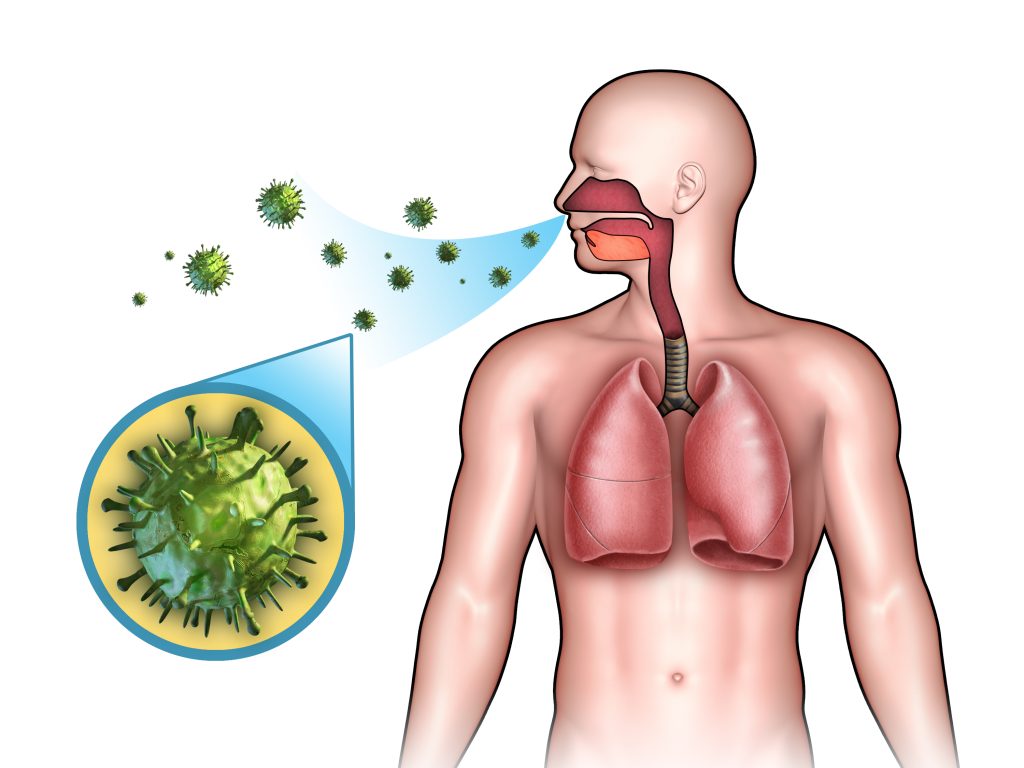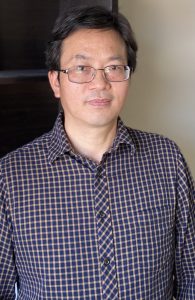Dr Jerry Zhang | Cleansing Indoor Spaces with Ultraviolet Light
Maintaining air quality in indoor spaces like shopping centres, stadiums, and airports is a key issue in modern society. Unfortunately, current air conditioning-based approaches are often energy intensive and inefficient. A viable alternative is the use of low-energy-consumption ultraviolet light disinfection systems, which cleanse the air of bacteria and pathogens in indoor settings. Dr Jerry Zhang and his team of ultraviolet light-based disinfection technology specialists at Bolb Inc. have developed a model to predict device performance and lifetime under different conditions, providing crucial guidance for their adoption in large-scale settings.
Cleansing Indoor Spaces
In our modern society, we spend significant time enclosed in large indoor spaces like airports, train stations, stadiums, and shopping centres. These places are often closely packed with other people and present ideal grounds for disease transmission. Following the COVID-19 pandemic, the question of how best to remove germs and pathogens from busy indoor spaces has become a hot topic.
Indoor air management is critical to human health. The number of air changes per hour (ACH) in an enclosed space is essential to maintaining indoor air quality while balancing pathogen reduction and the amount of oxygen and carbon dioxide.
Moving Away from Traditional Air Conditioning
One standard approach to air quality control is to adopt Heating Ventilation and Air Conditioning (HVAC)-based methods, which are both energy intensive and costly. This, combined with a need to develop green solutions that reduce carbon emissions, means that a novel approach to indoor air-quality maintenance is required.
Increased use of indoor facilities has led researchers to search for new, greener ways to address the problem of maintaining an ACH that provides acceptable indoor air quality. The key to reducing energy usage lies in developing new technologies that can effectively cleanse the air in a closed space. One option involves the use of a particular type of light.
Different Types of Light
All radiation belongs to a complete spectrum of different types of radiation with varying energies and wavelengths (if we describe light as periodic waves, this wavelength is the distance between two adjacent peaks). Some types of radiation are visible, while some are more or less able to penetrate matter. Other types are dangerous to DNA.
Ultraviolet (UV) radiation sits on the shorter-wavelength region of the spectrum, near-visible light. This radiation is defined as UVA, UVB, and UVC (with the shortest wavelength).
Using Light as a Disinfectant
Radiation of shorter wavelengths, such as UVC, can damage biological matter because it carries enough energy to break bonds within molecules. This allows UVC to demonstrate significant germ and virus-killing properties.
Light-emitting diodes, or LEDs, are robust low-energy devices that emit light of a particular wavelength range when electricity runs through them. UVC LED Volumetric Illumination Disinfection of Air (UVC LED VIDA) systems are a promising option for providing acceptable indoor air quality. These systems involve an array of UVC LEDs installed either on the ceiling of a large indoor venue or pointing upwards to the ceiling in such a way as to deliver a sufficient UV dose to the air in the space.

Device Lifetime
One fundamental problem for UVC LED VIDA developers Dr Jerry Zhang and his team at Bolb Inc. is understanding exactly how these LEDs perform over long timescales, which is crucial to determining how they may be deployed in large-scale settings. As the usable lifetime of these UVC LED devices is a crucial factor for their commercial use, the researchers investigated their performance over long periods.
Dr Zhang and his team developed an accurate model to predict the usable lifetimes of these devices beyond the tested timescales. Their UVC LED lifetime prediction model works on two assumptions: that defect generation in LED devices is the sole cause for decaying internal quantum efficiency (the effectiveness of a light-emitting device to convert injected electrons into photons) and that defect generation occurs to maximise the molecular disorder, or entropy, of these defects.
The team defined LED lifetime as the operating time in which they maintain 70% of their initial light output power. The model provided the team with LED lifetime predictions, together with information about their dependence on the temperature of the active part of the LED and the amount of electric charge flowing through it. The team’s model fits well with real lifetime data for UVC LED devices subjected to different currents and ambient temperatures for 2,500 to 10,000 hours.
Heating things up
Dr Zhang’s team also found that UVC LED lifetime can be sensitive to the temperature of an LED’s active region, where a lower temperature helps LEDs generate more light and reduces light decay. They found that an increase in ambient temperature from 25 to 60°C could slash the lifetimes of some UVC LEDs by up to ten times.
Using their model, the researchers also projected a lifetime of 96,000 hours for a long-lifetime UVC LED, which still maintained 83.5% of its initial light output power at 10,000 hours.
The researchers discovered a clear dependence of LED lifetime on the temperature of the LED active region and the amount of electric charge flowing. The team discovered that this temperature thermally activates defects in LEDs, while the amount of electric charge flowing there leads to a multiplication of these defects. The model also provided the team with an LED optical output power time evolution function, which fits well with full sets of lifetime data for all tested UVC LEDs.
Future of Light-Based Disinfection
Large-scale applications of UVC LED VIDA systems include the disinfection of basketball courts, movie theatres, megabuildings, subway tunnels, airports and train stations, indoor horticulture, and modern pig farming. Dr Zhang and the team at Bolb Inc. are considering future developments of these systems, such as using AI human presence sensing in conjunction with indoor air disinfection technology, which would involve mapping human presence and absence, de-energising and energising UVC LEDs, and counting dose to air in indoor spaces.
Cost, efficiency, and human safety are key factors prompting the large-scale deployment of UVC LED VIDA systems. Indoor air disinfection using UVC LEDs is a key application that could potentially eliminate pandemics and reduce energy bills associated with HVAC systems, with potential global energy savings of ~2.4 trillion kWh/year, which would amount to global monetary savings of $544 billion/year. The model developed by Dr Zhang and his team suggests that under the right conditions, these devices can provide high ACHs and long lifetimes in a low-cost and green approach to eliminating airborne disease transmission – and, therefore, pandemics.
SHARE
DOWNLOAD E-BOOK
REFERENCE
https://doi.org/10.33548/SCIENTIA957
MEET THE RESEARCHER

Dr Jerry Zhang
Bolb Inc.
Livermore, CA
USA
Dr Jerry (Jianping) Zhang obtained his doctorate from the Institute of Semiconductors, Chinese Academy of Sciences in 1999, and joined the Department of Electrical Engineering at the University of South Carolina as a postdoctoral researcher in the same year. In 2002, Dr Zhang published the first paper on ultraviolet C-band LEDs, before successfully developing milliwatt-level UVC LEDs. Dr Zhang has worked on UVC and visible LEDs in various industrial and academic positions, and cofounded Bolb Inc. in 2014 to produce commercial UVC LEDs. Dr Zhang serves as both the Chief Technology Officer and Chairman for Bolb Inc. and focuses on developing efficient and transparent UVC LEDs and understanding their light extraction efficiency and radiative recombination processes. Dr Zhang and his team work to continuously improve the efficiency and lifetime of UVC LEDs, and explore their potential for energy saving and pandemic prevention. Dr Zhang’s work is revolutionising the field of indoor disinfection, paving the way for cheaper, more sustainable solutions.
CONTACT
FUNDING
D Zhang and team at Bolb Inc. are grateful to their funders SL Energy, ODtech, Walden International, SK Telecom Americas, UVC Tech, and Fluxunit.
FURTHER READING
J Zhang, L Zhou, Y Gao, et al., Defect Dynamics and Internal Quantum Efficiency Decay Resultant Ultraviolet C‐Band Light‐Emitting Diode Lifetime Performance, Physica Status Solidi (A) Applications and Materials, 2022, 220(16), 2200433. DOI: https://doi.org/10.1002/pssa.202200433

REPUBLISH OUR ARTICLES
We encourage all formats of sharing and republishing of our articles. Whether you want to host on your website, publication or blog, we welcome this. Find out more
Creative Commons Licence (CC BY 4.0)
This work is licensed under a Creative Commons Attribution 4.0 International License. 
What does this mean?
Share: You can copy and redistribute the material in any medium or format
Adapt: You can change, and build upon the material for any purpose, even commercially.
Credit: You must give appropriate credit, provide a link to the license, and indicate if changes were made.
SUBSCRIBE NOW
Follow Us
MORE ARTICLES YOU MAY LIKE
Professor Giorgio Buttazzo | Artificial Intelligence and a Crossroads for Humanity
Where do we stand with artificial intelligence? Might machines take over our jobs? Can machines become conscious? Might we be harmed by robots? What is the future of humanity? Professor Giorgio Buttazzo of Scuola Superiore Sant’Anna is an expert in artificial intelligence and neural networks. In a recent publication, he provides considered insights into some of the most pressing questions surrounding artificial intelligence and humanity.
Professor Martin Trefzer | Bridging Nature and Artificial Intelligence for Smart Electronics Technology
The ever-developing world of artificial intelligence (AI) stands at the tip of a transformative breakthrough. Professor Martin Trefzer from the University of York and Professor Jim Harkin from Ulster University have introduced a revolutionary approach to neural network design. They work on an electronic system based on AI that forms the basis of the cross-disciplinary project called Nervous Systems, which aims to build electronic neuromorphic devices with an artificial intelligence system mirroring the adaptability and responsiveness of biological neural systems.
Dr Jon Tore Lieng | Dynamically Installed Anchors for Floating Offshore Turbines
Effectively harnessing offshore wind presents a valuable opportunity to increase energy supplies. Floating wind turbines present several advantages over traditional fixed turbines in more shallow waters. Dr Jon Tore Lieng from Deep Sea Anchors and colleagues have developed a type of dynamically installed anchor to hold the structures in place while reducing both the costs and complexity associated with installation where cohesive seabed sediments are realised.
Dr Sébastien Weber | PyMoDAQ: Navigating the Future of Data Acquisition
In an era where data is paramount, Dr Sébastien Weber and his team at CNRS, the French National Centre for Scientific Research, are changing the landscape for scientists and engineers with PyMoDAQ, an open-source data acquisition software. Their revolutionary tool stands out for its accessibility, versatility, and the thriving community it fosters.




